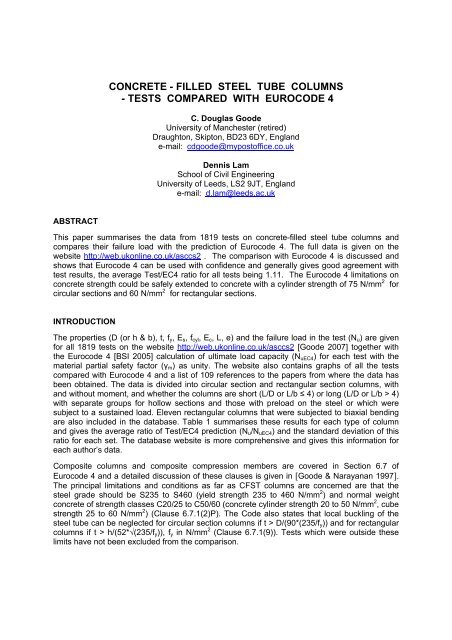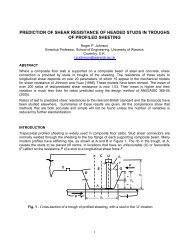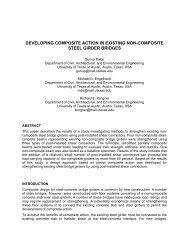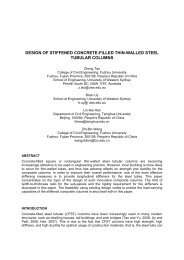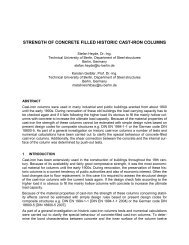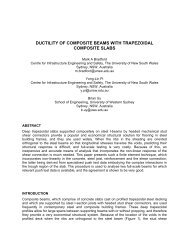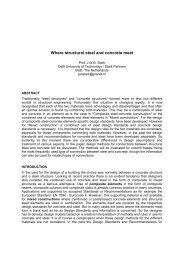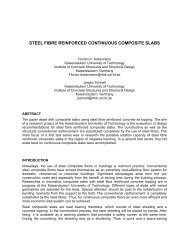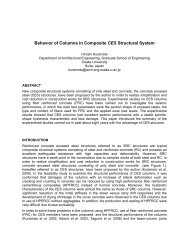concrete - filled steel tube columns - tests ... - CCVI Information
concrete - filled steel tube columns - tests ... - CCVI Information
concrete - filled steel tube columns - tests ... - CCVI Information
You also want an ePaper? Increase the reach of your titles
YUMPU automatically turns print PDFs into web optimized ePapers that Google loves.
CONCRETE - FILLED STEEL TUBE COLUMNS- TESTS COMPARED WITH EUROCODE 4C. Douglas GoodeUniversity of Manchester (retired)Draughton, Skipton, BD23 6DY, Englande-mail: cdgoode@mypostoffice.co.ukDennis LamSchool of Civil EngineeringUniversity of Leeds, LS2 9JT, Englande-mail: d.lam@leeds.ac.ukABSTRACTThis paper summarises the data from 1819 <strong>tests</strong> on <strong>concrete</strong>-<strong>filled</strong> <strong>steel</strong> <strong>tube</strong> <strong>columns</strong> andcompares their failure load with the prediction of Eurocode 4. The full data is given on thewebsite http://web.ukonline.co.uk/asccs2 . The comparison with Eurocode 4 is discussed andshows that Eurocode 4 can be used with confidence and generally gives good agreement withtest results, the average Test/EC4 ratio for all <strong>tests</strong> being 1.11. The Eurocode 4 limitations on<strong>concrete</strong> strength could be safely extended to <strong>concrete</strong> with a cylinder strength of 75 N/mm 2 forcircular sections and 60 N/mm 2 for rectangular sections.INTRODUCTIONThe properties (D (or h & b), t, f y , E s , f cyl , E c , L, e) and the failure load in the test (N u ) are givenfor all 1819 <strong>tests</strong> on the website http://web.ukonline.co.uk/asccs2 [Goode 2007] together withthe Eurocode 4 [BSI 2005] calculation of ultimate load capacity (N uEC4 ) for each test with thematerial partial safety factor (γ m ) as unity. The website also contains graphs of all the <strong>tests</strong>compared with Eurocode 4 and a list of 109 references to the papers from where the data hasbeen obtained. The data is divided into circular section and rectangular section <strong>columns</strong>, withand without moment, and whether the <strong>columns</strong> are short (L/D or L/b ≤ 4) or long (L/D or L/b > 4)with separate groups for hollow sections and those with preload on the <strong>steel</strong> or which weresubject to a sustained load. Eleven rectangular <strong>columns</strong> that were subjected to biaxial bendingare also included in the database. Table 1 summarises these results for each type of columnand gives the average ratio of Test/EC4 prediction (N u /N uEC4 ) and the standard deviation of thisratio for each set. The database website is more comprehensive and gives this information foreach author’s data.Composite <strong>columns</strong> and composite compression members are covered in Section 6.7 ofEurocode 4 and a detailed discussion of these clauses is given in [Goode & Narayanan 1997].The principal limitations and conditions as far as CFST <strong>columns</strong> are concerned are that the<strong>steel</strong> grade should be S235 to S460 (yield strength 235 to 460 N/mm 2 ) and normal weight<strong>concrete</strong> of strength classes C20/25 to C50/60 (<strong>concrete</strong> cylinder strength 20 to 50 N/mm 2 , cubestrength 25 to 60 N/mm 2 ) (Clause 6.7.1(2)P). The Code also states that local buckling of the<strong>steel</strong> <strong>tube</strong> can be neglected for circular section <strong>columns</strong> if t > D/(90*(235/f y )) and for rectangular<strong>columns</strong> if t > h/(52*√(235/f y )), f y in N/mm 2 (Clause 6.7.1(9)). Tests which were outside theselimits have not been excluded from the comparison.
For circular CFST <strong>columns</strong> enhancement factors (‘eta’ (η) factors, Clause 6.7.3.2(6)) can beapplied to allow for the increase in <strong>concrete</strong> strength caused by the confining effect of the <strong>steel</strong><strong>tube</strong> which produces a triaxial compressive stress state in the <strong>concrete</strong> thus increasing itsfailure load [Hobbs et al 1977]. For rectangular section CFST <strong>columns</strong> the Code takes thefailure stress in the <strong>concrete</strong> as the cylinder strength, without the 0.85 factor that is applied inunrestrained <strong>concrete</strong> to relate the <strong>concrete</strong>’s cylinder strength to its uniaxial strength.Overall buckling is allowed for in the Code by introducing a buckling factor (χ) related to therelative slenderness, λ , by the buckling curve (Clause 6.7.3.5(2)). When there is a moment onthe column two methods of analysis are permitted. A ’simplified’ method in which the secondordereffects (P-Δ effect and member imperfections) are allowed for by multiplying the first-orderapplied moments by a factor ‘k’ (greater than unity) and a more exact method where thesecond-order effect, the lateral deflection due to the end moment, is analysed and allowed for.When comparing with the <strong>tests</strong> the member imperfections have been assumed to be zero andboth the ‘simplified’ and ‘second-order’ methods have been used to analyse long <strong>columns</strong> withan end moment and the results are included in the database and summarised in Table 1 of thispaper. In the simplified method the calculated strength has been divided by the ‘k’ factor tocompare with the test result (rather than factoring the test result by ‘k’) and the failure loadpredicted by the code is compared with the test result at the same axial load/moment ratio aswas used in the test.DISCUSSION AND COMPARISON WITH EUROCODE 4GeneralIt can be seen from Table 1 that the average failure load in the test divided by the Eurocode 4prediction (Test/EC4) value for each type of column is greater than unity indicating thatEurocode 4 predicts a lower value than the test and thus a ‘safe’ result.Table 1 – Summary of results for each type of column.Type of ColumnNumber of Average St Dev ofTests Test/EC4 Test/EC4Short Circular No Moment 368 1.06 0.091Long Circular No Moment 369 1.17 0.148Long (and a few short) ‘k’ factor method254 1.15 0.111Circular with Moment 2 nd order analysis 254 1.15 0.119Short Rectangular No Moment 330 1.09 0.096Long Rectangular No Moment 212 1.06 0.097Short rectangular with Moment 29 1.01 0.108Long Rectangular ‘k’ factor method96 1.10 0.097with Moment 2 nd order analysis 96 1.20 0.148Short Hollow Circular No Moment 76 1.22 0.095Circular with Moment and Preload on <strong>steel</strong> 23 1.15 0.123Rectangular with Moment and Preload on <strong>steel</strong> 19 1.03 0.099Long Rectangular No Moment with Sustained Load 8 1.25 0.051Square, 8-sided, 16-sided Hollow No Moment 24 1.16 0.108Totals (excluding Biaxial Bending, ‘k’ factor analysis) 1808 1.11 0.108Rectangular with Code straight line interaction 11 1.52 0.058Biaxial Bending Elliptical interaction, α M = 1 11 1.20 0.041
2.001.75Ratio Test / EC41.501.251.000.75Code limits0.500 10 20 30 40 50 60 70 80 90 100 110Concrete Cylinder Strength N/mm2Short circular (364) Long circular (364) Circular with M (255)Circ with M & Pre (23) Hollow (100)Figure 1. Circular section <strong>columns</strong>. Ratio Test/EC4 against Concrete cylinder strengthBecause of the number of <strong>tests</strong> involved the separate groups cannot be distinguished in themore densely tested zones in these black and white figures. However, the general trend is clear;the individual <strong>tests</strong> can be distinguished in the coloured graphs on the website.2.001.75Short Rect. (330) Long Rect. (212)Rect. with M (125) with M & Pre or Sus (27)Ratio Test / EC41.501.251.000.75Code limits0.500 20 40 60 80 100 120Concrete Cylinder Strength N/mm2Figure 2. Rectangular section <strong>columns</strong>. Ratio Test/EC4 against Concrete cylinder strength
Ratio Test / EC42.001.751.501.251.00Short circular (364)Long circular (369)Circ. with Moment (255)0.750.500.00 0.50 1.00 1.50 2.00 2.50Local buckling criteria. Eurocode 4 implies local buckling possible if > 1Figure 3. Circular Columns. Ratio Test/EC4 against Eurocode 4 local buckling criteriaRatio Test / EC42.001.751.501.251.00Short rectangular (330)Long rectangular (212)Rect. with Moment (125)0.750.500.0 0.5 1.0 1.5 2.0 2.5Local buckling criteria. Eurocode 4 implies local buckling possible if > 1Figure 4. Rectangular Columns. Ratio Test / EC4 against local buckling criteriaLocal bucklingThe Test/EC4 ratio plotted against the local buckling criteria is shown in Figure 3 for the circularsection <strong>columns</strong> and in Figure 4 for the rectangular section <strong>columns</strong>. There is a generaldownward trend in the results for both circular and rectangular section <strong>columns</strong> when the localbuckling criteria is exceeded ( > 1.0) so it is probably desirable to keep the existing limits. Insome <strong>tests</strong> the <strong>steel</strong> would have had to be over twice as thick to satisfy the Code criteria;
however, in all cases where the Code condition is exceeded, if a 0.75 factor were applied to theEurocode 4 prediction the <strong>tests</strong> would be safe.SlendernessFigure 5 (short <strong>columns</strong> without moment), Figure 6 (long <strong>columns</strong> without moment) and Figure 7(<strong>columns</strong> with an end moment) show the ratio Test/EC4 against slenderness. They all showthat the Code method of allowing for slenderness is satisfactory. Indeed, as Figure 6 shows, forcircular <strong>columns</strong> without moment there is a slight upward trend in the ratio as the <strong>columns</strong>become more slender; this could be because the buckling factor (χ) used in the code isconservative when the <strong>columns</strong> are slender. However, it would be prudent for no changes to bemade to the Eurocode 4 buckling factor unless further <strong>tests</strong> confirm this trend.2.001.75Ratio Test / EC41.501.251.000.75Short circular (364) Short rectangular (330)0.500.00 0.05 0.10 0.15 0.20 0.25 0.30Slenderness SQRT(NplRk/Ncrit)Figure 5. Short <strong>columns</strong> without moment. Ratio Test/EC4 against Slenderness2.001.75Ratio Test / EC41.501.251.000.75Long circular (369) Long rectangular (212)0.500.0 0.5 1.0 1.5 2.0 2.5 3.0Slenderness SQRT(NplRk/Ncrit)Figure 6. Long <strong>columns</strong> without moment. Ratio Test/EC4 against Slenderness
2.001.75Ratio Test / EC41.501.251.000.75Circular Circ. + preload Short Rect.Long Rect. Rect. + preload Rect. + sus. load0.500.0 0.2 0.4 0.6 0.8 1.0 1.2 1.4 1.6Slenderness = SQRT(Npl.Rk/Ncrit)Figure 7. Columns with moment. Ratio Test/EC4 against SlendernessHollow sections (rows 10 and 14 in Table 1)Hollow sections were formed by spinning the <strong>steel</strong> <strong>tube</strong> with some <strong>concrete</strong> in it so thatcentrifugal force leaves a hole in the <strong>concrete</strong>. All the hollow sections used low strength<strong>concrete</strong>, none greater than 40 N/mm 2 , and gave column strengths about 20% greater thanpredicted. This may be due to the difficulty of measuring the true strength of the spun <strong>concrete</strong>which might be higher than the measured cylinder strength. However, it appears that hollowsections can be designed safely using Eurocode 4 if the hole is allowed for.Preload and sustained load (rows 11, 12, 13 in Table 1)Pre-load (up to 60% of the capacity of the <strong>steel</strong>) on the <strong>steel</strong> <strong>tube</strong> before filling with <strong>concrete</strong>seems to have had no effect on the strength; the average Test/EC4 for the 23 circular <strong>columns</strong>(11 short and 12 long) being 1.15 (SD 0.123) and for the 19 rectangular <strong>columns</strong> (10 short and12 long) being 1.03 (SD 0.099). The eight <strong>tests</strong> which sustained an average load of between53% and 63% of their capacity for 120 or 180 days before being loaded to failure carried aslightly higher load before failing (average Test/EC4 = 1.25) than their six comparison <strong>tests</strong>without sustained load (average Test/EC4 = 1.08); these six companion <strong>tests</strong> are included in the212 <strong>tests</strong> of row 6 of Table 1.Biaxial bendingOnly eleven <strong>tests</strong> on rectangular <strong>columns</strong> with biaxial bending are reported and these all failedat much higher loads than predicted by Eurocode 4, average Test/EC4 was 1.52. The Codeuses a straight line interaction for the bending resistance between the two axes with anadditional safety factor α M , (with α M as 0.9 for <strong>steel</strong> grades S235 to S355 and 0.8 for <strong>steel</strong>grades S420 and S460, Clause 6.7.3.7). Using an elliptical interaction between the momentsabout the two axes and omitting this additional safety factor, ie. α M = 1, gives much closeragreement with the test failure load, an average Test/Prediction of 1.20 for these eleven <strong>tests</strong>;see the last two rows of Table 1.
CONCLUSIONSa) Eurocode 4 can be used with confidence for the design of <strong>concrete</strong> <strong>filled</strong> <strong>steel</strong> <strong>tube</strong><strong>columns</strong>. The average Test/EC4 ratio from 1808 <strong>tests</strong> being 1.11.b) For circular section <strong>columns</strong> the Code limitation on <strong>concrete</strong> cylinder strength could besafely extended to 75 N/mm 2 (cube 94 N/mm 2 ). Even <strong>columns</strong> with cylinder strengthsabove 100 N/mm 2 (cube 125 N/mm 2 ) were safe, though more <strong>tests</strong> with such highstrength <strong>concrete</strong> are desirable to justify using the Code with such high strength<strong>concrete</strong>.c) For rectangular section <strong>columns</strong> the <strong>concrete</strong> strength limitation could be safelyextended to 60 N/mm 2 . When higher strength <strong>concrete</strong> is used its cylinder strengthshould be factored by 0.85, equivalent to assuming no enhancement of <strong>concrete</strong>strength due to containment.d) Sections, both circular and rectangular, which have a wall thickness thinner thanpermitted by the local buckling Clause 6.7.1(9) could be used if a factor of 0.75 wasapplied to the strength predicted by Eurocode 4.e) Hollow sections can be designed using Eurocode 4 provided allowance is made for thehole.f) Neither preload on the <strong>steel</strong> <strong>tube</strong> nor sustained load on the <strong>filled</strong> column had anysignificant effect on the failure strength of the column.g) More testing of rectangular <strong>columns</strong> under biaxial bending is needed. The eleven <strong>tests</strong>reported show the straight line interaction used in Eurocode 4 to be very safe(Test/EC4 = 1.52) and an elliptical interaction might be preferable (Test/Prediction =1.20).REFERENCESBSI 2005. British Standards Institution. Eurocode 4: Design of composite <strong>steel</strong> and <strong>concrete</strong>structures – Part 1-1: General rules and rules for buildings. BS EN 1994-1-1:2004. MiltonKeynes, BSI, 2005.Goode 2007. Website with database of all 1819 <strong>tests</strong> and 109 references to this data:http://website.ukonline.co.uk/asccs2 (also available for £5 as a CD with all data, supplementarycalculations and analysis from Douglas Goode, e-mail: cdgoode@mypostoffice.co.uk )Goode & Narayanan 1997. Goode C. D. and Narayanan R. ‘Design of <strong>concrete</strong> <strong>filled</strong> <strong>steel</strong><strong>tube</strong>s to EC4’, International Conference on Composite Construction – Conventional andInnovative, Seminar by ASCCS on Concrete Filled Steel Tubes, Innsbruck, 18 September 1997,p 1-25.Hobbs et al 1977. Hobbs D. W., Pomeroy C. D. & Newman J. B. ‘Design stresses for <strong>concrete</strong>structures subject to multi-axial stresses’, The Structural Engineer, 55/4, 1977, p 151-164.
NOTATIOND outer diameter of the circular <strong>steel</strong> <strong>tube</strong>h larger dimension of the rectangular <strong>steel</strong> <strong>tube</strong>b smaller dimension of the rectangular <strong>steel</strong> <strong>tube</strong>t thickness of the <strong>steel</strong> <strong>tube</strong>f y yield stress of the <strong>steel</strong>E s modulus of elasticity of the <strong>steel</strong> (E a in EC4) = 200 N/mm 2 if not given by the testerf cyl cylinder strength of the <strong>concrete</strong> = 0.8f cu if cube strength given by the testerf cu cube strength of the <strong>concrete</strong>E c secant modulus of elasticity of the <strong>concrete</strong> to 0.4f cyl= 22*((f cyl + 8)/10)^0.3 if E c was not given by the testerL length of the columne eccentricity of load on the end of the column, causing end momentN uEC4 ultimate load capacity of the column as calculated using Eurocode 4N u axial load at failure in the testχ buckling factor = 1/(φ + √(φ 2 - λ ) ) where φ = 0.5*(1 + 0.21*( λ - 0.2) + λ 2 )λ slenderness ratio = √(N plRk /N cr )N plRk plastic resistance of the composite sectionN cr elastic critical load = π 2 (EI) eff /L 2(EI) eff effective flexural stiffness of the composite section = E a I a + 0.6*E c I ck factor to take account of second order effects in the simplified analysis, which,for <strong>columns</strong> with equal end moment, = 1/(1 – N u /N cr,eff )where N cr,eff uses (EI) eff,II = 0.9*(E a I a + 0.5*E c I c ) to obtain the elastic critical load


